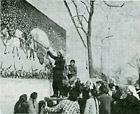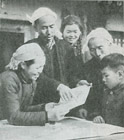China Reconstructs January 1974, pp. 21-23
I am an ordinary peasant woman.
In 1958 I started to paint in my spare time. Since then I have completed 300 pictures. Not long ago, three of them, "Spring Hoeing", "Our Fertilizer Factory Goes into Production" and "Sowing in the Rain", were shown at the Exhibition of Paintings by Peasants of Huhsien county, Shensi province, held in Peking. This is a tremendous encouragement to me.
Before liberation, no one would even dream of a peasant woman like me doing art work. When I was small I loved to draw and cut things out. In my home village, we had the custom of decorating the windows with papercuts every New Year. Each time the festival came around my mother would make these "window flowers" and, sitting by her, I would learn to cut them out. Sometimes I did the whole job - drawing, cutting out and pasting them on the windows myself. The neighbors said I had a quick mind and clever hands.
But in those days there was no chance for me to go to school. Our family was very poor. I had many younger brothers and sisters. From the time I was very small I had plenty of household chores to do. During the day I went out to gather firewood. In the evenings I had to help mother spin thread and weave cloth.
In 1949 when liberation came I was already 15. But I could not read or write a single character. Soon the village organized a shorttime literacy class. It was my first opportunity to study and I started to learn to read and write.
In 1958, when the Great Leap Forward began in agriculture, our Huhsien county started building a reservoir. To liven up cultural life and heighten enthusiasm, the county Party committee started an amateur art class on the worksite. There the members worked, and there they painted.
When I heard that each commune had been asked to nominate one or two members for the class, I immediately signed up and my commune Party committee promptly approved. It was in that class that I first studied Chairman Mao's Talks at the Yenan Forum on Literature and Art and realized why we should paint for the workers, peasants and soldiers. During the stirring construction work I painted, with some help from professional artists, a poster called "Heroes Lock Up the Dragon" to show the heroic spirit of the commune members who were conquering nature. This was my first step forward in the field of art.
It was no easy matter for a working woman like me to take up creative art. I worked in the fields most of the year and had family duties at home. I could only paint in the little time I had for rest. Moreover, some conservative people looked askance at a village woman painting and made cold, sarcastic remarks. But I thought of Chairman Mao's teaching: "If socialism does not occupy the rural front, capitalism assured-
p. 21
ly will." And I recalled how, after the liberation, the class struggle in the cultural field in the countryside continued to rage. Among the means by which the overthrown landlord class still tried to corrupt people were old paintings, full of feudal superstitions. We had to fight against this. It was up to us poor and lower-middle peasants to take over the field of culture in the countryside, and never allow the reactionary classes to dictate to us again. I vowed to myself, "With Chairman Mao backing us and pointing the way, we will paint. We'll never retreat!" In this spirit I've kept on painting, despite all difficulties, for 16 years now.
With little education, I had never had any basic training in painting. Sometimes, hard as I tried, I still couldn't paint what I wanted to. Once I did a picture of militiamen training. When the young people saw it, they said the figures were all short and squat like "Plump Sister-in-law" in the old folktale. I decided to make a special effort to grasp the essentials of painting, and started learning to sketch. Usually I tried to remember scenes I encountered, which I would later draw at home. Or I would take a sketch pad along to the fields or to meetings and sketch during rest periods. Sometimes, while making the fire or cooking a meal, I would suddenly think of a good scene and do an outline sketch right away. As time passed, people who saw my work began to commend my progress, saying, "Now your things look real." Gradually I turned out quite a lot of papercuts, wall paintings, posters, serial-picture-stories and lantern slides.
When the Great Proletarian Cultural Revolution came, I plunged into the fierce struggle with my paint brush as a weapon. In murals and lantern slides I angrily repudiated Liu Shao-chi's counter-revolutionary revisionist line. When the struggle reached a sharp point, an overthrown landlord and some other bad eggs in our village started to make trouble secretly, provoking quarrels among some commune members, setting one against the other to disrupt our unity. I decided to expose these class enemies with my painting. I did a series of "family histories", showing how poor and lower-middle peasant families had been exploited and oppressed by these very same scoundrels before the liberation. This series was put on show in the village. All the scenes were like bullets striking at the class enemies, and their heads began to droop. Some young people, who had not seen through these enemies before, woke up after looking at the pictures. Finding how much they deflated the enemy, many poor and lower-middle peasants said happily: "That's right, that's the way to fix them!"
Since the cultural revolution, there's a fresh spirit in our village. People often ask me to do paintings on new themes, like Tieh-mei from The Red Lantern, Yang Tzu-jung from Taking Tiger Mountain by Strategy and other heroes and heroines of the model revolutionary Peking Operas. I've taught an amateur art class in the village primary school and helped paint posters on walls along the village streets. I've tried harder and harder to show what was new in our socialist countryside.
In autumn 1971 our Kuangming commune got a very good cotton harvest. The bolls blossomed out like silver flowers. During the rush season we women worked from dawn to dusk. We picked cotton in the fields, and drove wagons or pulled carts on the roads, to deliver and sell cotton to the state. Everywhere there was the sound of our laughter and song. Moved deeply by the scene, I wanted so much to paint it. Forgetting food and rest, right after work one evening I started on "Joyful Cotton Picking". But it didn't come out well the first time - just a plain picture of women picking cotton. When other commune members saw this first version, they said: "Feng-lan, the bolls look real all right and the women have on their new clothes, but where's our revolutionary spirit?"
After collecting everybody's opinions I made a second sketch. It had fields of unpicked cotton as background, with a few women picking and one patch finished. In the foreground were seven women each pulling a handcart brimming over with new cotton. They were running as if racing with a young man driving a cotton wagon. Although this version still had shortcomings, everybody said it was much better than the first. Then I understood what had been wrong with my previous effort. It was mainly that it didn't show the commune members' revolutionary fire in building socialism.
Our part of Shensi province, the Kuanchung area, is wheat country. In spring when the winter wheat turns green again, we women do the hoeing. The countryside is especially beautiful then. Gardenlike wheat fields of tender green contrast with pink peach blossoms in full bloom. Going to work at such times I can hardly tear my eyes away. And I have always wanted to paint the scene to show the moving beauty of the new socialist countryside and how enthusiastic we women commune members are in building it. So, while I worked, I started to carefully observe the people working around me. And during rest breaks I made sketches of them. It was on this basis that I started, amended and finally created "Spring Hoeing". It contains 16 persons, each of whom I had previously sketched. The middle-aged woman in the blue jacket in front is based on sketches of our women's team leader in our brigade.
I started this painting in 1972. And from then till it was finished I kept collecting opinions and made many changes. The painting exhibited in Peking last year was the fourth version. In it the portrayal of the people had improved somewhat.
With support from the brigade Party committee, four of our young village girls and I have organized an amateur art group. The county cultural center often sends professional artists to help us and we've learned a good deal from them. There can be no end to painting for the workers, peasants and soldiers. Our new socialist countryside has so much that needs to be painted. I am determined to persevere along Chairman Mao's revolutionary line in art, and to paint more and better to give expression to our new era.
p. 23
The photographs published with the article:

